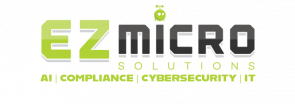ONEDRIVE VS. SHAREPOINT: WHAT’S THE DIFFERENCE & WHICH ONE IS RIGHT FOR YOU?
If your business is using Microsoft 365, you’ve probably come across OneDrive and SharePoint—two tools designed to help you store, manage, and share files. While they might seem similar at first glance, they serve different purposes and have distinct strengths. Understanding the differences between them can help you choose the right tool for the right job.
WHAT IS ONEDRIVE?
OneDrive is a personal cloud storage service where users can save their own files, access them from any device, and share them with others when needed. Think of it as your personal filing cabinet in the cloud.
- Best for: Individual use and small-scale sharing
- Common uses: Drafting documents, storing personal files, quick file access on the go
When used in a professional setting, it utilizes SharePoint shared libraries to create the business OneDrive and make file-sharing easier and more secure.
WHAT IS SHAREPOINT?
SharePoint is a collaboration platform that provides a centralized space for teams to store, manage, and work on documents together. It’s designed for shared access and team collaboration, often with more advanced permissions, version control, and automation features. It is also the backbone for OneDrive when deployed in a professional environment.
- Best for: Team collaboration and document management
- Common uses: Project folders, department file libraries, intranet sites
Key Differences at a Glance
| Feature | OneDrive | SharePoint |
| Ownership | Individual user | Team or department |
| Access | Private by default | Shared by default |
| Collaboration | Basic real-time co-authoring | Advanced collaboration + workflows |
| File storage location | User’s OneDrive folder | Team site document libraries |
| Permissions management | Basic (user-level) | Detailed and customizable |
| Integration | Strong with Office apps | Strong with Microsoft Teams, Power Automate, etc. |
INTEGRATION & SYNCING
- OneDrive uses SharePoint in the background: When you store files in Microsoft Teams or a SharePoint site, they’re actually saved in SharePoint document libraries. Accessing shared libraries via OneDrive (under “Shared Libraries”) means you’re viewing SharePoint content.
- Syncing: Both OneDrive and SharePoint files can be synced to your local device using the OneDrive sync client, giving you offline access and easier file management.
PROS & CONS
OneDrive Pros:
- Easy to use and familiar for most users
- Great for personal file storage and quick sharing
- Access files from any device
- Real-time co-authoring with Office apps
OneDrive Cons: if not connected to SharePoint
- Not ideal for long-term team collaboration
- Harder to manage shared files as teams grow
- Permissions can become messy if not managed well
SharePoint Pros:
- Designed for collaboration and team-based file structures
- Advanced permission control and security settings
- Built-in version history and document management tools
- Can create custom workflows, sites, and dashboards
SharePoint Cons:
- Steeper learning curve for new users
- Can feel overwhelming if not set up properly
- Requires more upfront planning and organization
SO, WHICH SHOULD YOU USE?
In most workplaces, the best setup is using both—OneDrive for personal work and SharePoint for team or department-level collaboration. If your organization wants to get the most out of Microsoft 365, it’s important to understand where each tool fits.
Need help setting up your OneDrive or SharePoint environment the right way? Our team can help you configure, manage, and train your staff on Microsoft 365 tools—so your business runs smarter, not harder.
Contact us today!
